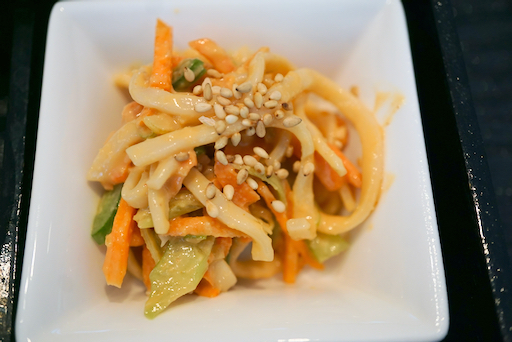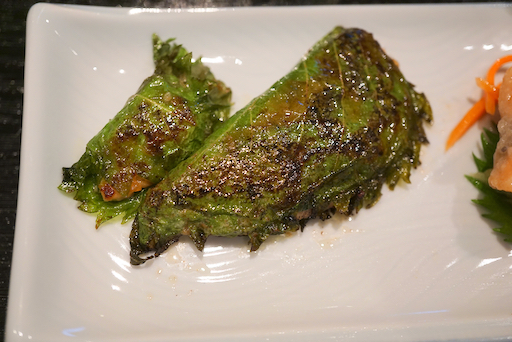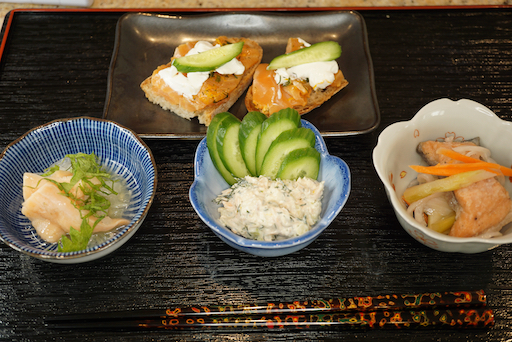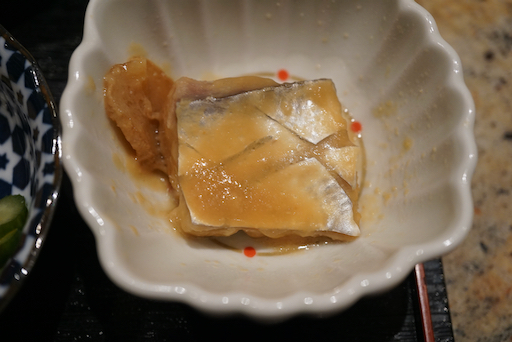Marinating: While the chicken pieces are still hot, add them to the sweet vinegar marinade. I also add thinly sliced red onion, julienned carrot, and red pepper flakes. You should add as much vegetables as you like or the marinade can accommodate. They are very good after pickling. I marinade them at least overnight or longer in the refrigerator.
Monday, September 20, 2010
Chicken breast "nanban", Escabeche Japanese style 鶏胸肉の南蛮
Marinating: While the chicken pieces are still hot, add them to the sweet vinegar marinade. I also add thinly sliced red onion, julienned carrot, and red pepper flakes. You should add as much vegetables as you like or the marinade can accommodate. They are very good after pickling. I marinade them at least overnight or longer in the refrigerator.
Thursday, February 4, 2016
Salmon nanban 鮭の南蛮漬け
Here is a close up with one piece of salmon covered with marinated carrot, onion and celery.
Monday, October 21, 2019
Capelin "nanban" シシャモの南蛮漬け
Along with this dish, I served store-bought "satsuma-age" fish cake 薩摩揚げ, "dashimaki" omelet だし巻き卵, sugar snap スナップ豌豆の塩びたし, simmered kabocha かぼちゃの煮物(center square plate) and boiled octopus leg with rapini. This was quite a big starter.
Ingredients:
One package (10) "shishamo" capelin thawed
2-3 Tbs potato starch "katakuriko" 片栗粉 for dredging
One sweet onion, halved and cut into thin strips
One medium carrot, peeled and cut into small julienne
Few dried Japanese "nanban" togarashi 南蛮唐辛子 red pepper, cut into small rings
One cup sweet vinegar (one cut rice vinegar, 1/2 cup sugar and 1tsp Kosher salt, boiled to dissolve)
1/2 vegetable or peanut oil for "shallow" frying
Direction:
Dredge shishamo with the potato starch (#1)
Add the onion and carrot in a sealable container and pour the hot sweet vinegar and let it cool to the room temperature (#2)
Shallow fry (or deep fry if you so prefer) in 1/4 inch deep oil (#3) for a few minutes and then turn over and cook another minute or two (#4)
Remove half of the vegetables from #2 and add the fried shishamo (#5)
Add back the vegetables to cover the fish (#6)
Put the lid on and refrigerate for a few hours or overnight.
As a rescue dish for old frozen shishamo, this was quite good. Frying and marinating in sweet vinegar really made it more than edible. Because of the preservative nature of the marinade, we kept enjoying this dish for a week (one small fish at a time). This dish is perfect for cold sake but not great with red wine because of the acidity.
Sunday, November 14, 2010
Duck "Nanban" Soba 鴨南蛮
We also enjoyed stewed "Kabocha" squash. As before this one was sold as "Butter cup" squash but I believe this is identical to a Japanese "Kabocha".
Thursday, December 29, 2016
Aji 3 ways 2nd version 鯵3種類第二弾
Sunday, August 7, 2016
Chicken kara-age and lotus root nanban 鶏の唐揚げピリ辛南蛮漬け
Wednesday, December 16, 2020
Cuttlefish legs with simmered vegetables イカの足いり根菜の煮付け
Friday, May 7, 2021
Three appetizers with two new ones 新しいお通し2種
I served these three appetizers one evening. The dish shown on the left in the first picture is my stand-by fried salmon in sweet vinegar or “salmon nanban” 鮭の南蛮漬け. The new ones are the one in the center “dried persimmon and daikon in sweet vinegar” 干し柿の大根なます and the one on the right, “udon noodle salad with peanut butter dressing” うどんのピーナッツバター和え.
2 dried persimmon, stem end and seeds removed and cut into strips.
1 inch segment of daikon, peeled, and cut into buttons then julienned.
Carrot and/or celery julienned (optional)
1/2 cup sweet vinegar (1/2 rice vinegar, 1/4 cup sugar or 2:1 ratio, pinch of salt, heat until dissolved. Then let it cool)
1 Tbs roasted white sesame seeds, fine ground (I used a Japanese mortar and pestle or suribachi.
1/2 tsp dark sesame oil
Directions:
Salt the daikon pieces and knead, then let it stand for 5-10 minutes.
Add all the ingredients and the sweet vinegar.
Let it marinate for at least 30 minutes in the refrigerator.
Ingredients: (amount is all arbitrary)
Cooked thin udon noodle
Carrot, julienned
Scallion, sliced thinly diagonally
Sesame seeds for garnish (or crushed peanuts)
For Dressing:
Peanut butter, soy sauce, and rice vinegar in 2:1:1 ratio
Dash of dark peanut oil
Sugar and sriracha to taste
Minced ginger and garlic to taste
Add warm water if the consistency is too thick
Directions:
Cut the noodles into 1-2 inch lengths (optional but for ease of eating)
Dress with the peanut dressing.
Garnish with sesame seeds or crush peanuts.
Saturday, July 25, 2020
Horse mackerel wrapped in perilla leaves 鯵の大葉バター焼き
4 raw jack mackerel or "aji" filets (thawed if frozen)
1 tbs miso
1 scallion, finely chopped
1/2 ginger, finely chopped
1/4 tsp soy sauce (optional)
1/4 tsp sugar
10 perilla leaves, washed and dried with stem end removed
Butter for frying
Directions
I first made "namerou" by chopping and pounding the aji with a sharp knife until the aji became a bit pastey. I mixed in the scallion, ginger, miso and sugar and kept pounding until well mixed. You could add a bit of soy sauce to adjust the seasoning and consistency. I placed a small amount of namerou on a perilla leave and folded it into half-moon shape (below)
Saturday, May 21, 2011
Fried shishamo in sweet vinegar 揚げシシャモの甘酢漬け
Sunday, July 19, 2020
Salmon appetizer 4 kinds 鮭のお通し4種
This is the usual salmon salad. Instead of crackers, I served it with slices of cucumber so that we would not get filled up too quickly.
Below is "salmon nanban" 鮭の南蛮漬け. This is a variation of nanban 南蛮. I made it with chicken, jack mackerel 鯵, "shishamo" ししゃも or capelin fish previously.
Thursday, June 29, 2017
Anchovies in sweet vinegar イワシの南蛮
Since I found Japanese "shishitou" 獅子唐芥子 at our near-by Whole foods, I added one, simply fried, as a garnish.
Ingredients:
Frozen (or fresh, if available) anchovy filets, thawed, three, cut into two making six pieces.
Potato starch for dredging
Peanuts or vegetable oil for deep frying
Celery (2 stalks), carrot (1 small), and sweet onion (1 small) cut into small strips (julienne)
For sweet vinegar marinade
Rice vinegar 1/2 cup
Japanese dashi 1/2 cup
Sugar 1/4 cup
Salt, a pinch
Light colored soy sauce, 1/2 tsp
Dried Japanese red pepper, 1 whole,
Directions:
Before starting to fry the fish, I prepared the vegetables and sweet vinegar.
I placed the ingredients for sweet vinegar in a sauce pan and heated it until the sugar melted. I let it simmer for 5 minutes and then let it cool to room temperature.
I added the julienned of vegetables.
I removed the whole Japanese hot pepper and sliced it into small rings removing the seeds for the garnish. (I did this in the morning and kept it in the refrigerator until I was ready to deep fry the fish).
I dried the fillets and dredged them in potato starch and deep fried them for 3 -4 minutes turning once in 350F oil, drained it on a paper towel (see below).
While the fish was hot, I placed it in the sweet vinegar and covered the fish with the vegetables (see below). You can enjoy immediately or keep it in the refrigerator for later.
For this type of strong flavored fish, "nanban" is a good preparation. We enjoyed this with cold sake.
Monday, January 10, 2022
New Year 2022 Jan 3 Salmon three ways 一月三日鮭尽し
We have been enjoying the items from the Sushi Taro osechi box. After indulging in a serving of wonderful dishes from the box which go perfectly with sake, I served this plate as the “second course”. The red and white fish cake or "kouhaku kamaboko" 紅白蒲鉾 (upper left in the picture) came from the osechi box (they were the last four slices). I made a deep pocket in each and stuffed the pink one with the leftover Maruhide sea urchin shutou 丸秀雲丹の酒盗 topped with a dab of wasabi. I topped the white one with Ikura marinated in soy sauce イクラの醤油ずけ topped with strips of nori.
The remaining items were all different salmon dishes which I prepared for New Year. Starting from right upper, clock wise, is salmon nanban 鮭の南蛮漬け、Russian marinated salmon 鮭のロシア漬け, and finally salmon kelp roll 鮭の昆布巻き. These three salmon dishes all have different textures and flavors. For the salmon nanban, the salmon was dredged in flour and fried before being marinaded in sweet vinegar which gave it a bit firmer texture. The Russian marinated salmon started out as thin strips of raw salmon marinated in sake, vinegar and oil without any sweetness. This year I something different. I added dijon mustard to the marinade and emulsified it with the “motor boat” emersion blender. As a result the oil didn’t separate or solidify. Also, the salmon did not “over cook” and had a lovely soft texture. Finally the salmon kelp roll was simmered for sometime in seasoning broth, producing a yet different soft and moist texture. These are wonderful to enjoy with sips of sake.
Sunday, August 21, 2011
Sardines escabeche イワシの南蛮漬け
Saturday, December 19, 2020
Appetizers 4 kinds お通し4種類
Ingredients:
3 Japanese eggplant
2 tbs neutral vegetable oil
two small pieces of ginger, crushed with the side of the knife.
250ml Japanese dashi broth (I made this with my usual bonito and kelp dashi pack)
3 tbs soy sauce
3 tbs mirin
(Instead of soy sauce, I am using "shirodashi" 白だしand light colored soy sauce).
Directions:
Cut the eggplants in half lengthwise. Shallowly cut the skin in crosshatching pattern and then cut lengthwise again to make 1/4 eggplant.
Add the oil to a frying pan on medium flame and add the ginger for a few minutes until fragrant.
Add the eggplants skin-side down and fry for 3-4 minutes and turn over to fry both of the fresh sides for 2-3 minutes each,
Add the seasonings and broth (below), put on the lid and simmer for 3-4 minutes.
This is good eaten hot right after it is cooked but it can also be stored in the broth in a sealable container in the refrigerator. The stored eggplant can be eaten cold or heated up in the microwave.
This is usual salmon nanban. This one was really good since the quality of the salmon (from Whole foods) was good and I did not over cook it. I served this with sugar snap in salt broth スナップ豌豆の塩びたし.
Mr. and Mrs. Segawa of Tako Grill kindly gave us "kazunoko" herring roe 数の子. I prepared it as I described in my New Year dish tab. The half serving shown below was soaked in dashi broth with soy sauce and mirin seasoning. I marinated the other half serving in sake-lee and miso mixture or "kasu-miso" 粕味噌. Since this preparation will last longer than the one soaked in dashi broth we will eat it closer to the holidays.
I also served Spanish mackerel in miso sauce 鯖の味噌煮. (The red dots surrounding the mackerel are part to the decoration of the bowel not part of the preparation.)
This was a quite a good starter line up for the evening.














































